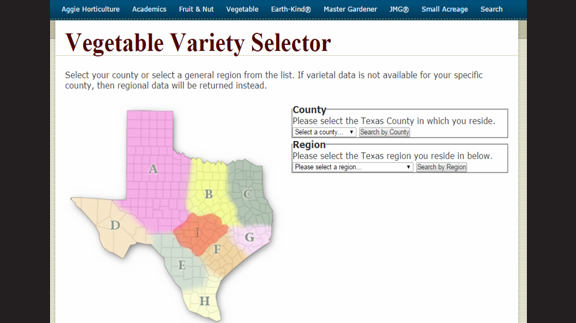Farm & Ranch
Picking vegetables to grow starts with knowing where to plant

By: Kathleen Phillips
Writer: Kathleen Phillips, 979-845-2872, [email protected]
Contact: Dr. Joe Masabni, 979-324-1244, [email protected]
COLLEGE STATION — No matter how you look at it, the online Texas Vegetable Variety Selector will help growers choose the best types to grow in a particular locale, according to Dr. Joe Masabni, Texas A&M AgriLife Extension Service horticulturist in College Station.
“It’s a one-stop website designed to help AgriLife Extension agents and the people they serve throughout the state,” said Masabni, the site’s creator. “I collected the variety recommendations from all the counties and updated them with the currently available varieties.”
At the site, http://aggie-horticulture.tamu.edu/publications/veg_variety/, a viewer can start with either a county or region. An interactive map helps the user determine how to select a location.
If a specific county is selected, Masabni explained, the user then can either select a specific vegetable or request a list of all vegetables for that county. The resultant list will provide several possibilities and the number of days required from planting to harvest.
If “all vegetables” is selected, the list will yield categories of vegetables with several possible varieties for each and the number of growing days before harvest in the specific county, he added.
No matter how you look at it, the online Texas Vegetable Variety Selector will help growers choose the best veggies to grow in a particular locale, according to Dr. Joe Masabni, Texas A&M AgriLife Extension Service horticulturist in College Station. Find the selector at http://aggie-horticulture.tamu.edu/publications/veg_variety/.
In some cases, a grower might want to view vegetable varieties that are good for a region, Masabni said.
“I designed the map to include a region primarily because some counties are in transition between two climatic zones, which makes it hard to determine which variety list to choose,” he said. “By choosing a region, one may get a more accurate list of vegetables rather than trying to guess which zone fits a location better.”
When selecting a region, the user can also narrow the list by specific vegetable or get a list of all vegetables with the varieties best suited for that area, Masabni said.
“Some crops and varieties can be grown in many regions of Texas. Other crops, such as onions, and some varieties, such as Celebrity tomato, are more adapted to particular regions than others,” Masabni said. “Choosing the right variety is a big step for a grower – whether commercial or at home – to have a successful crop.”
The database contains information for more than 240 counties and eight regions, he said. In all, more than 40 vegetables and 200 varieties are listed for possibly growing in the state.
At this point, there isn’t information for Far West Texas, Masabni said, though he is working to determine varieties for that region and will add them soon.
“The list of varieties comes from two sources – from results of research conducted by AgriLife Extension specialists and county agents and from demonstration trials,” he added. “Some varieties that are not on the list may have worked well for a gardening enthusiast but are not on our list, pending research-based trials.”
-30-
Farm & Ranch
Hazards of Backyard Poultry

By Barry Whitworth, DVM
Having backyard poultry is a popular agriculture enterprise. According to the United States Department of Agriculture, 0.8 percent of all households in the United States have chickens. People keep chickens for a variety of reasons with table eggs being one of the more common reasons.
Unfortunately, some of these poultry producers are not aware of the hazards that come with keeping poultry because many times they carry pathogens but appear healthy.
Chickens are carriers of several zoonotic diseases. These are diseases that can be passed from animals to humans. According to a recent survey in Pennsylvania, a majority of backyard poultry producers were aware of the dangers of avian influenza. However, this study also revealed that far fewer producers were aware of the risk of possible exposure to Salmonella and Campylobacter.
The lack of knowledge about the hazards of raising poultry likely contributes to the continued issues of Salmonella outbreaks associated with backyard poultry. In 2023, the Centers for Disease Control and Prevention reported 1,072 illnesses of Salmonella linked to backyard poultry, and 272 of those patients required hospitalization. Oklahoma reported 43 individuals with the disease.
To read more, pick up a copy of the April issue of NTFR magazine. To subscribe by mail, call 940-872-5922.
Farm & Ranch
Ag Elsewhere: Wyoming

By Tressa Lawrence
Babies are tucked away in every nook and cranny. Many ranchers across Wyoming have baby animals popping up all over this time of year.
Farm & Ranch
Ag Elsewhere: Montana

By Lindsey Monk
Another load of grain in to keep feeding the calves until the green grass can really start popping.
-

 Country Lifestyles1 year ago
Country Lifestyles1 year agoScott & Stacey Schumacher: A Growth Mindset
-

 Equine7 months ago
Equine7 months agoThe Will to Win
-

 Country Lifestyles7 years ago
Country Lifestyles7 years agoStyle Your Profile – What your style cowboy hat says about you and new trends in 2017
-

 Country Lifestyles4 years ago
Country Lifestyles4 years agoAmber Crawford, Breakaway Roper
-

 HOME7 years ago
HOME7 years agoGrazing North Texas – Wilman Lovegrass
-

 Country Lifestyles7 years ago
Country Lifestyles7 years agoDecember 2016 Profile, Rusty Riddle – The Riddle Way
-

 Country Lifestyles8 years ago
Country Lifestyles8 years agoJune 2016 Profile – The man behind the mic: Bob Tallman
-

 Outdoor9 years ago
Outdoor9 years agoButtercup or Primrose?






